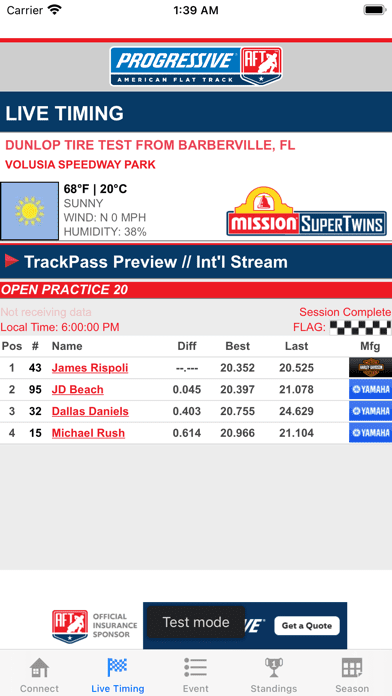
How to get started in flat-track
Content
Turn circles on a clay ring, slide in turns and no front brake
We tried flat track on a Harley 750 Street Rod in Croatia and loved it!
The flat track is probably one of the oldest motorcycle races, a concept first reserved for bicycles and then for motorcycles running in circles on an oval clay ring of 1⁄4, 1⁄2 or 1 mile, just over 400, 800 or 1600 meters. on which we turn counterclockwise. The motorcycle does not have a front brake or headlight and is fitted with uncut tires. If the discipline is now celebrating its centenary, it is largely dominated by Harley-Davidson. Some names then helped publish flat or dirt track like Smokin 'by Joe Petrali.
The principle is simple: there is no front brake and you need to control the sliding curve inputs and lateral curve outputs. Usually, if you are a little like me, feel a little attention on the road, you should only be afraid of the program statement.
Basically, the bet is simple: you need to succeed in doing the naked opposite of what you do on the road. Put the corner on the ground, try to move the bike. In short, things that are not easy to hold up for the mainstream tourist caste of which I am a part.
We are in Croatia in a small hillside village and Harley-Davidson has created a small flat-road track, brought in a supply of barely prepared 750 Street Rod and, as instructors, provided us with nothing more than Grant Martin, the current Hooligan Series European Championship leader, and also Ruben House, who, in addition to a great career in WSBK and MotoGP, is also known for taking pictures of the Ducati Hypermotard 1100 SP, drifting off both wheels, knee to the ground and said hello with one hand. Pork ribs, so he knows well, and it won't be a luxury to try to convince us to push the car into the ground. Was that good? How do we do it? We will tell you ...
A few words of history
Flat trekking is an integral part of American motorcycle culture as, according to the archives of the AMA (American Motorcycle Association), the first races date back to 1924 and the first championship in this discipline was established in 1932. We see it: it's outdated!
The championship was almost constantly monitored by Harley-Davidson, which has long been the only manufacturer consistently involved in the discipline. The early decades were marked by a battle between Harley and Native American, while Indian went bankrupt in the mid-1950s (and as a result Harley won all successive championships between 1954 and 1961, for example), BSA and Triumph tried it in the 1960s. and Yamaha didn't try it until the 1970s (a real oddity, the mechanical base of the CX 500 turned upside down to accommodate longitudinal mode, with 4 valves per cylinder and offset increased to 750 and connected to a chain transmission). That didn't stop Harley from winning 9 out of 10 championships in the 1980s, and it makes Milwaukee's most successful producer in the genre a little special, very popular in the United States, but still has minor breakthrough problems elsewhere.
Today, after a bit of a slump over the success of motocross and supercross, flat track is truly back in vogue in the United States as two national brands, Harley-Davidson and Indian, compete again.
Motorcycle
It's very simple: it's a barely modified Harley-Davidson street bar. The wheels remain at 17 inches but are now fitted with Avon ProXtreme rain tires (inflated to 2 bars) which are very suitable for this type of surface. The changes made to the bike are simple: the front brake (sic) completely disappears, the lights and turn signals, the mudguards and passenger footrests removed, the new saddle and rear shell assembly is added, and the air box replaced. The final gear remains the same as the suspension adjustment. So much for our test bikes.
Compared to a real race car like the Grant Martin's Street Rod that tops the Hooligan Series European Championship: in addition to the narrower 19-inch wheels (fitted in the Dunlop DT3), there is little work on exhaust and mapping; the tank is the Sportster tank (but it has to decorate), the real tank is in. We can see that the preparation of the flat road bike is actually not very difficult.
Equipment
Real WADA drivers usually combine caterpillar leather and helmet with cross-country boots. We followed this type of mix: Bering Supra R track leather, Adventure Form boots, AGV AX-8 Evo helmet.
The only obligation is to put an iron sole under the left boot, be able to lean on it and help the bike to rotate and tie the circuit breaker around your wrist before leaving ... This thing is tricky!
Technique
It is Ruben House who explains to us: "This is a heavy motorcycle, this is not a real off-road motorcycle, but we have to fight it." Here, moreover, the circuit is particularly small. “You will only be using first and second speeds, and as with the outsole under the left boot, which is heavy and difficult to change gears, you start at second, starting at full speed. The tricky part of the flat path is that there is no front brake and that if you want to be able to control the bike, you still need a mass transfer, and therefore everything will be decided by the driving position and the motor brake impulse. "
The further he goes, the less I'm sure!
“In the first line, you will be in the second. Before cornering, you abruptly disengage the throttle, release the rear brake slightly, lower the grade first, release the clutch, and tilt the bike to the rope point. What is needed is a weight put on the front to accompany the bulk transfer. If the gesture is done well, the bike starts to position itself at an angle, and you accentuate the rounding of the rear tire, which will return more engine brakes and help you turn. At the same time, the left leg touches the ground, well on the axis of the bike, otherwise you break the ligaments and press on the thigh and calf to support and help you spin the bike. "
Good good. What's next?
“Then you must always lean forward to act as if you want to bite your elbow. After the rope stitch, straighten the bike and put on the throttle and you still stay in front to maintain directional power, it's a shame that if the rear sweeps the path, it's the front that helps you get on the right trajectory. Then you stay completely, walk both and again to turn. "
#skepticism.
So is it okay?
To be honest: I was a little afraid of this day. Fear not to get there, afraid to fall, afraid to hurt me. We don't wash thirty years of driving on a road like this.
But still. It took me about ten seconds (first contract time) to get into the game. The bike is already cool, spicy. Besides, it makes a nice noise with the racing exhaust, we believe it. So yeah, the lack of a front brake is downright scary. So yes, too, start with the second, the gas is large, it immediately sets the mood.
It only took me a few laps to start feeling the real sensation: indeed, pushing the body forward, passing first, making the bike go around a corner on the ground, it’s all quick and enjoyable, and you can feel the wriggle of the rear transmission and help you turn. The force on the leg makes muscles work that were not necessarily tense, and I had a little trouble in the early circles of the morning, but this came naturally in the afternoon.
Then we work on the details: the position of the upper body, the fact of not accelerating too hard, and looking for thrust out of the curve, projecting turn by turn, making it a chore to the point where we no longer count circles. Then we value the sensation: hearing the sound of a metal sole rubbing on the ground, stepping out of a drifting curve, full throttle, flush with straw boots, pulling things against colleagues during fights neatly organized by Harley, trying to make in and delay corner entry, without the front and cheap and yet quite intense!
Obviously, this is just contact. But drawing corners on the ground, feeling a soft drift of the back at the entrance to the curve, do not worry anymore, because you do not have brakes before, all these are real sensations, and it was with a smile on my face that I left every session.
What if you get into the game?
There is the European Championship, the Hooligan series, reserved for two-cylinder machines with a volume of at least 750cc. At the moment, the championship consists of only 3 rounds, including 5 in the UK and one in the Netherlands, which is a guarantee on the European side. But discipline seems to be on the rise as Sweden, for example, has a fairly high national championship.
At the European Championships, the tracks are longer (about 400 meters), and in the heat you can find up to 12 motorcycles at the same time. So tempted?
And the future?
Harley-Davidson hit us: "We do it for fun, there is no strategy or product plan behind it." Very good. However, we note that the discipline is very popular in the US (and a little bit in Italy), that Indian will release the 1200 flat track next year, that Ducati has a flat track school with Scramblers in Italy and that this thing may well become the next hipster hip mount. But Harley tells us they have nothing in the boxes. Wait and see.
